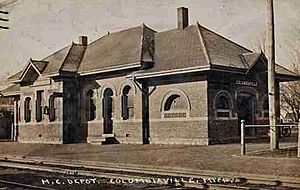Columbiaville station facts for kids
Quick facts for kids
Columbiaville
|
|
|---|---|
 |
|
| Location | 4643 First Street, Columbiaville, Lapeer County, Michigan 48421 |
|
Detroit–Bay City Railroad Company Columbiaville Depot
|
|
| Location | 4643 First Street Columbiaville, Michigan |
| Built | 1893 |
| Architect | William Peter (1824–1899) |
| Architectural style | Late Victorian, Queen Anne, Richardsonian Romanesque |
| NRHP reference No. | 84001785 |
| Significant dates | |
| Added to NRHP | April 5, 1984 |
The Columbiaville Station used to be a busy train station. Today, it's known as the Columbiaville Rotary Club and Public Library. You can find it at 4643 First Street in Columbiaville, Michigan. This old building is very important! It became a Michigan State Historic Site in 1979. Later, in 1984, it was added to the National Register of Historic Places. This means it's a special place worth protecting.
Contents
A Historic Train Station
The Columbiaville Station was built in 1893. It replaced an older station from 1872. This building served as a train station for a long time. It was open from 1872 until 1964.
Why Was It Important?
The station was a key stop for trains. These trains traveled between Detroit and Bay City. It helped the area grow a lot. Both people and goods traveled through this station.
The Man Behind the Station
A man named William Peter (1824–1899) was important to Columbiaville. He was a lumber businessman. Peter moved to the area in 1847. In 1871, he helped plan the village of Columbiaville. To help his business, Peter made a deal. He worked with the Detroit–Bay City Railroad Company. This agreement led to the first train station. The station built in 1893 helped even more. It made transportation along the railway much better.
What Happened Next?
The station stopped being used for trains in 1964. The railway itself closed down in 1977. Today, the building has a new purpose. It is home to the Columbiaville Rotary Club. It also houses a public library.
Building Style
The Columbiaville Station is a mix of different styles. It shows Late Victorian, Queen Anne, and Richardsonian Romanesque architecture. It's a small, one-story building. The walls are made of brick and are very thick. They are about 18 inches (46 cm) thick! The inside still looks much like it did. It has its original wood panels, floors, and ceiling. Even the painted brick walls are original.




